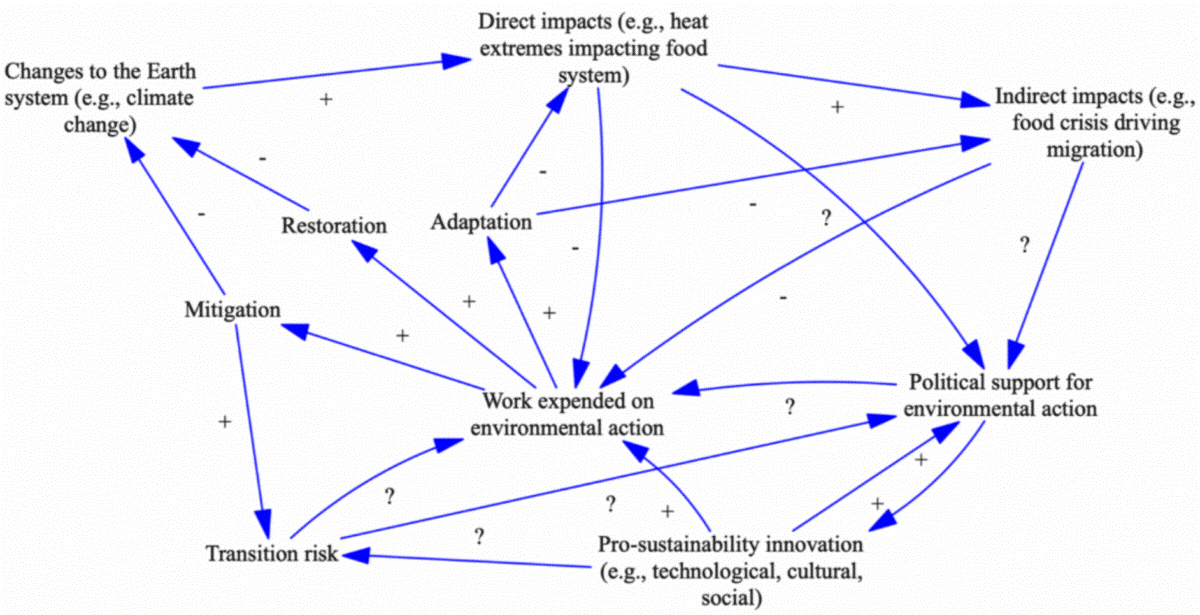
A sustainable transition can fail long before societies run out of solutions, if worsening impacts erode the ability to act itself.
Derailment risk describes a scenario where societies are too occupied with the consequences of environmental change — such as climate change and nature loss — to adequately address their causes. It highlights the impact of delayed mitigation, restoration and adaptation on societies’ capacity to safely execute a sustainable transition.
What Is Derailment Risk?
Tom Strachan
Derailment risk was first described in an article by researchers Laurie Laybourn, Joseph Evans and James Dyke, published in the journal Earth System Dynamics in November 2023. It is defined as the risk that the sustainable transition is obstructed by the worsening impacts of environmental change.
The authors state that the physical and transition risks from environmental change can affect societies’ capacity to mitigate, restore, adapt and innovate (henceforth, adaptive capacity), by pressuring the political, economic, social and ecological (henceforth, socio-ecological) systems upon which these actions depend.
The longer that mitigation, restoration, adaptation and innovation are impeded, the greater the severity of the future physical and transition risks, and, in turn, the greater the erosion of our adaptive capacity. If left unchecked, this feedback loop (illustrated in Figure 1) could render societies incapable of undergoing a sustainable transition, leading to runaway climate change and nature loss.
Figure 1: The Feedback Loop Between Physical and Transition Risks and the Erosion of Adaptive Capacity.

Source: GARP, based on Laybourn, Evans and Dyke (2023)
The Dynamics of Derailment
Derailment risk is concerned with the dynamics that could lead to the systemic failure of a sustainable transition itself. It reframes environmental risk management as a matter of both avoiding climate- and nature-related damages and safeguarding our adaptive capacity. Table 1 provides examples of how climate- and nature-related physical risks can both directly and indirectly erode adaptive capacity.
Table 1: How Climate- and Nature-Related Physical Risks Erode Adaptive Capacity
|
|
Direct impact |
Indirect impact |
|
Climate-related physical risk |
Increased frequency of heatwaves leads to more days of unsafe working conditions, impeding the construction of green infrastructure and increasing the cost of action. |
Increased frequency of heatwaves leads to decreased crop yields, displacing affected populations. This increases immigration pressure in less affected areas, diverting attention and resources away from environmental action.
|
|
Nature-related physical risk |
Deforestation erodes soil quality, causing a higher proportion of reforestation efforts to fail and increasing the cost of action. |
Deforestation erodes soil quality, leading to increased crop failure, reducing the supply and increasing the cost of food. This exacerbates existing economic inequality and creating social unrest, diverting attention and resources away from environmental action. |
Source: GARP, based on Laybourn, Evans and Dyke (2023)
Similarly, transition risks also can erode adaptive capacity. For example, sudden shifts in policy, law, technology, markets or sentiment could create financial instability, curtailing investment and impeding a sustainable transition. Knock-on economic impacts could in turn reduce political support for the transition itself.
However, a sustainable transition also provides significant opportunities for mitigation, restoration, adaptation and innovation, all of which boost adaptive capacity. These activities also produce economic and social co-benefits, which could reinforce support for the transition.
Overall, the net impact of transition risks versus transition opportunities on adaptive capacity is unclear. Figure 2 illustrates the dynamics of derailment risks across socio-ecological systems, highlighting positive, negative and ambiguous interactions.
Figure 2: The Dynamics of Derailment Risks

Note: Positive polarities — where element A has an increasing effect on element B — are illustrated with a + sign. Negative polarities — where element A has a decreasing effect on element B — are illustrated with a – sign. Ambiguous polarities — where the overall effect is unclear — are illustrated with a question mark.
Source: Laybourn, Evans and Dyke (2023)
Managing Derailment Risk
For risk managers, managing derailment risks means shifting from a narrower focus on loss minimization to a broader focus on building and preserving resilience. It requires identifying and protecting the systems and services — critical infrastructure, governance structures, financial stability, public trust, ecological integrity — that underpin long-term adaptive capacity.
This demands a dynamic approach: as derailment risk evolves, strategies must anticipate non-linear escalation, tipping points and the possibility of systemic breakdown in the sustainable transition. In practice, effective management will involve integrating derailment risk into scenario analysis, stress testing and contingency planning, ensuring that risk frameworks account for both direct losses and the erosion of adaptive capacity.
This perspective encourages early action: front-loading mitigation, restoration and adaptation efforts to prevent the feedback loop from tightening. It also underscores the importance of co-benefit strategies that simultaneously address environmental change and reinforce societal resilience, reducing the risk that the sustainable transition is undermined from within.
By way of example, consider a national infrastructure authority responsible for energy, transport and water systems. Under a traditional climate risk lens, it might model flood damages to transport routes or supply chain disruptions from extreme weather. Under a derailment risk lens, though, the authority would stress test a compound scenario: a series of heatwaves disrupts renewable infrastructure construction, simultaneously causing agricultural failures that trigger food price spikes and social unrest. The model would assess not only the economic losses, but the resulting political instability and public opposition to further transition measures. This stress test might reveal that without pre-emptive investment in heat-resilient construction practices, diversified food supply chains and public communication strategies, the sustainable transition plan could collapse under political and economic pressure long before its technical goals are reached.
Parting Thoughts
Derailment risk threatens the entire risk management apparatus by undermining the institutions, systems and services that enable action. For risk professionals tasked with safeguarding long-term value, derailment risk demands a shift in focus towards resilience and early action.
For a deep-dive on derailment, listen to the podcast Beyond 1.5°C: How to Think About Our New Climate Reality with the lead author of the original article, Laurie Laybourn.
To learn more about how to identify, assess and manage climate and nature-related risks facing your business, consider signing up for our Sustainability and Climate Risk (SCR®) Certificate.
Tom Strachan is Assistant Vice President at the GARP Risk Institute, specializing in sustainability and climate and nature risk management. He holds a BA in Geography from the University of Exeter and a MSc in Environmental Technology from Imperial College London.
Topics: Physical Risk, Transition Risk, Climate Risk Management, Nature Risk Management